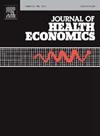心理保健利用和自杀的地区差异:来自澳大利亚搬家者的证据
IF 3.6
2区 经济学
Q1 ECONOMICS
引用次数: 0
摘要
心理健康状况不佳是一个重大的全球健康问题,许多国家记录了未满足需求的严重程度和心理保健利用方面的区域差异。为了确定如何最好地解决这些差异,重要的是要了解驱动区域差异的因素。利用澳大利亚人口普查相关的微观数据,我们利用跨区域迁移来确定患者和地点因素在多大程度上推动了精神卫生保健服务和精神卫生处方(抗抑郁药、抗焦虑药、抗精神病药)利用方面的区域差异。我们发现,在精神卫生保健服务和精神卫生处方的利用方面,地方因素分别占大约72%和19%的区域差异,其余的反映了与患者相关的需求。我们也发现了暗示性的证据,更大的地方效应预示着更少的心理健康相关的急诊科就诊,自残住院和自杀。总之,我们的研究结果表明,在低利用率地区存在供应不足和不公平,而不是在高利用率地区存在效率低下的高利用率。本文章由计算机程序翻译,如有差异,请以英文原文为准。
Regional variation in mental healthcare utilization and suicide: Evidence from movers in Australia
Poor mental health is a major global health issue, with many countries documenting high levels of unmet need and regional disparities in mental healthcare utilization. To determine how best to address these disparities, it is important to understand what drives regional variation. Using Census-linked microdata from Australia, we exploit cross-region migration to identify the extent to which patient and place factors drive regional variation in utilization of mental healthcare services and mental health prescriptions (antidepressants, anxiolytics, antipsychotics). We find that place factors account for approximately 72 % and 19 % of the regional variation in utilization of mental healthcare services and mental health prescriptions, respectively, with the rest reflecting patient-related demand. We also find suggestive evidence that larger place effects predict fewer mental health related Emergency Department presentations, self-harm hospitalizations, and suicides. Altogether, our findings suggest there is inadequate and inequitable supply in regions with low utilization, rather than inefficiently high utilization in high utilization regions.
求助全文
通过发布文献求助,成功后即可免费获取论文全文。
去求助
来源期刊

Journal of Health Economics
医学-卫生保健
CiteScore
6.10
自引率
2.90%
发文量
96
审稿时长
49 days
期刊介绍:
This journal seeks articles related to the economics of health and medical care. Its scope will include the following topics:
Production and supply of health services;
Demand and utilization of health services;
Financing of health services;
Determinants of health, including investments in health and risky health behaviors;
Economic consequences of ill-health;
Behavioral models of demanders, suppliers and other health care agencies;
Evaluation of policy interventions that yield economic insights;
Efficiency and distributional aspects of health policy;
and such other topics as the Editors may deem appropriate.
 求助内容:
求助内容: 应助结果提醒方式:
应助结果提醒方式:


